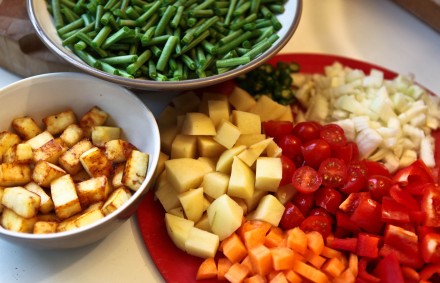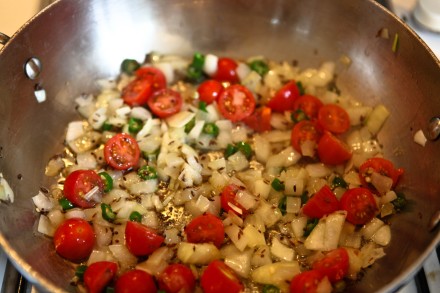I have been extremely tardy with my *Meat Free Tuesday* posts the last few weeks! It all started so well, but then I got caught up in friends and family time and never got around to posting. Rest assured, I have continued with the ritual, albeit not blogging my efforts! For this reason, I have a special post planned for next week that should make up for the missed entries. Some hints as to the theme are that it will be spicy, sweet, savoury, refreshing and all about the outdoors! I hope you will come back to check it out!
In the meantime, I am sharing with you a simple, but favourite vegetarian dish of mine. When I was a child I would always looked forward to this for two reasons: firstly because it contained paneer (Indian soft cheese), one of my favourite things to eat as a child and secondly it was always so colourful; you eat with your eyes first, right? My mother wouldn’t make this very often as my father prefered paneer in the bhurji style (crumbled and soft like scrambled egg) . In this dish the paneer in compressed into blocks, cubed and then fried- you can buy both the blocks and pieces- fried and unfried at both Indian and regular supermarkets all over the UK. If you buy the blocks, simply cube and deep or shallow fry until a gentle golden edge is achieved evenly. A home made version is tastier and softer, but a little time consuming. It all boils down to the milk (no pun intended :) ) I say this because in Canada, the store bought paneer is excellent and I am sure it’s down to the milk. I highly recommend the Canadian brand Guru Nanak if you have that in your area- saves a lot of time! In the following weeks I shall be dedicating a post to paneer with a recipe of how to make your own at home as it’s a useful ingredient to make for use in both sweet and savory recipes as well as a great way to use up excess milk!
My mother would tend to make this dish when we had people over as it contains no real objectionable vegetable for the token fussy eater to dislike and so the chances are that it would be enjoyed by all. The other reason I have chosen to share this recipe is because it is extremely versatile meaning that you can substitute other vegetables that you have to hand. What makes this dish is the masala base. If you can master this, you can apply this to virtually any vegetable combination with minor adjustments and or additions. Each combination will taste different as the masala will enhance each vegetable’s natural flavour. This recipe is simple, quick and delicious.
Mum’s Mixed Vegetable Subzi
Ingredients
For the base masala:
1 onion finely chopped
1-3 green chillies chopped finely (the long thin kind you get in Indian grocers Rocket chillis. They have the best flavour and aren’t ridiculously hot- a less hot version of Thai bird’s eye chilies. If in North America, I prefer the flavour of Jalapeno to Serrano chilies, but I have found Rocket chilies in some specialist stores there, too)
a handful of baby plum tomatoes halved/ the equivalent of what you have to hand or 1/2 a tin
1 tsp cumin seeds
2 1/2 tsp ground coriander
1/2 tsp garam masala plus extra for sprinkling
1/2- 3/4 tsp turmeric
1/2 tsp red chili powder (to taste, also bear in mind the heat you get from your green chilies and adjust accordingly)
salt to taste
3-4 tbsp oil
Additional spices specific to this dish
1tsp mustard seeds
1 tsp fennel seeds whole
1 tsp fennel seeds crushed for sprinkling
The Vegetables
1 carrot cubed
1 large or 2 small red peppers cubed
3-4 golf ball size potatoes cubed
1 pack of fine Kenya beans or fine french beans (about 200-250g) cut into 2cm pieces
To make it colourful- throw in some sweetcorn too if you have it
1- 1 1/2 cups cubed and fried paneer
coriander to garnish
Method
- To prepare the base masala that you can use with almost all vegetables, heat a wide based pan with 3-4 tbsp oil to a moderately high heat.
- Add the cumin, and for this particular recipe also add the mustard seeds and whole fennel seeds and allow to splutter. You can use the mustard seeds with most vegetables also, but the fennel seeds tend to only marry well with certain combinations such as with aubergine, bitter gourd and okra- although for my taste, I wouldn’t put mustard seeds with either of the last two. There is no wrong or right, per se- you just need to experiment and find the flavour combinations that you enjoy.
- Next add the onions and green chilies and allow the onions to become slightly translucent. You do not need to caramelise them. About 5 mins.
- Then add the tomatoes and cook to soften them and you start to see the oil separating. About 5 mins. (See picture above)
- Next add the ground spices- turmeric, coriander, red chili powder and salt. (I always use about 1 1/2 tsp for most dishes and it’s fine. You can adjust later too) Fry these for a minute. Do not let them touch down in the pan. This is now your base masala complete. (See picture above)
- Now add all the vegetables and on high heat stir well to coat the vegetables with all the masala.
- Bring pan to a steaming heat and before putting on the lid to steam, sprinkle over the crushed fennel seeds and garam masala. For other vegetable combinations I would just use the garam masala, but it is not an essential stage- it can be omitted.
- Put a lid on and put the heat right down to the lowest setting on a gas cooker. If you are using another kind of stove, bring the heat down to a 2-3 so that it’s just below a simmer. You want to gently steam the vegetables without them catching on the bottom of the pan and without adding water.
- The dish is ready when the vegetables are cooked- about 10-15 mins.
- Garnish with fresh coriander and a little sprinkling of crushed fennel seeds if you like.
Serve with fresh naan or roti and yogurt. This makes a great main dish or vegetable accompaniment. Try it together with a dal for a complete vegetarian Indian meal.











